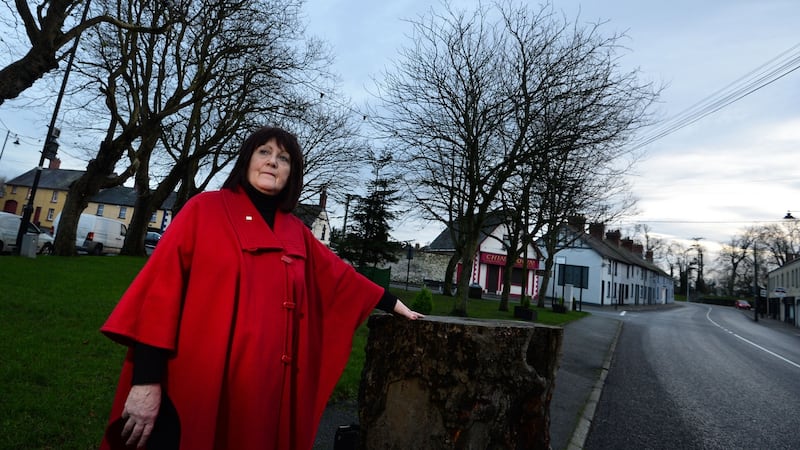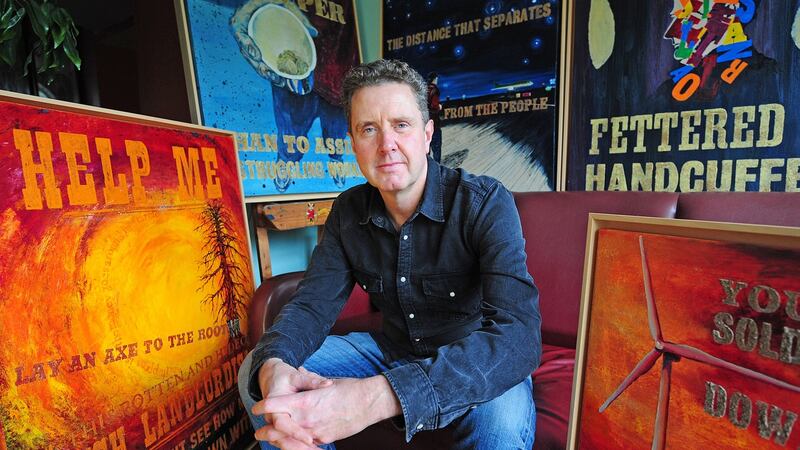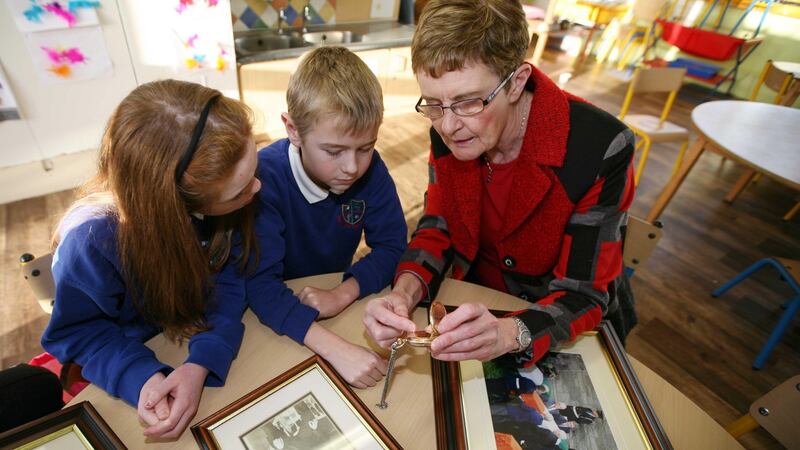Paddy Murray
Homecoming, steel ship sculpture Francis Street, Kilrush, Co Clare (from July)
Used as a marching tune by the Volunteers during the Rising, generations of Irish children have been singing it ever since without realising its associations. Óró Sé do Bheatha 'Bhaile was the inspiration for artist blacksmith Paddy Murray's giant Homecoming ship sculpture that will be silhouetted against the River Shannon for years to come.


“I saw a programme on the 1916 Rising and someone said it was an ancient Jacobite song, that was re-written by Pearse,” says Murray. “I never knew that. The song was calling the diaspora back, exhorting them to return home to fight for a new Ireland.”
The opening lines to the song, “Óró sé do breath ‘bhaile, anois ar theacht an tsamhraidgh” will appear on the sails of the ship.
The sculpture is designed so that anyone can get on board, walk up the helm and be pictured on the Shannon with the ship’s sails blowing behind them.
“For a moment, they are one of those people taking part in the story, they are the ones coming back to Ireland to take part in the Rising,” says Murray.
Murray’s own experience of the 1966 commemoration also played a part in designing his submission. “When I was in primary school and was given a copy of the Proclamation with a wooden frame on it, I always remembered that because it was something concrete. That also gave me some inspiration in making something that is accessible for people. I think a sculpture can stir the imagination and stir the memory.
“When people see it down in the marina, they will say, ‘Oh I learned that song,’ and it will trigger something with them each time. And when the song and dance is over this year, we have something left on the ground to show the children nowadays, who will be adults in 2066, what we did to commemorate the Rising.”

Brendon Deacy
Sioraí, oil painting exhibition at the Museum of Australian Democracy, Australia (online at brendondeacy.com)
If Brendon Deacy’s exhibition is irrelevant by 2116, he’ll be happy about it. While the Laois-based artist didn’t know much about the political activist, land agitator and patriot James Fintan Lalor when he began his project two years ago, he fast became an admirer.
Lalor’s writing had a seminal influence on many people, including Pádraig Pearse. The 1916 leader called him “one of the four evangelists of Irish freedom”.
Although Lalor died long before the Rising was even planned, the most interesting thing about him for Deacy was that the relevance of his words applied as much during the Rising as they do in the 21st century.
“There’s no visual art there of Lalor, apart from a fairly pedestrian portrait sketch, so I had very little reference material to go on for a visual exhibition,” says Deacy.
“But then I decided to look at his writings, and the frightening thing was that his words are so relevant to what is happening in present day Ireland. I took his words verbatim and floated them above images of contemporary Ireland.”
To give his work a metaphysical connection between the work and Lalor, he mixed debris from the ruins of Lalor’s house with oils, to create his 10 paintings.
“There go the young, the gifted, the daring, the wise,” are Lalor’s words set to a backdrop of flight departures from Terminal 1. “Rather create a pauper than assist a struggling worker,” shows the all too familiar coffee cup, held out by a homeless person asking for help.
The year “1916 was the pivotal event in modern Irish history”, says Deacy. “It was led by true visionaries. But I hope that for a better Ireland, this project might not be relevant in the future, which is a strange thing to say about your own work.”

Dr Madge O’ Boyle
The name of the first RIC officer to die during the Rising is rarely, if ever, mentioned. Charles McGee, a native Irish speaker from Inisboffin in Donegal, joined the RIC in 1913 and was shot three years later in Castlebellingham, Co Louth, on Easter Monday.
He was unheard of for almost 100 years but his grand-niece Dr Madge O’Boyle, a historian, has now written a book that she hopes will bring some recognition and insight to the man who, even within her own family, was barely spoken about.
“His picture was always in the drawer when I was a child and it was nearly saying, ‘Don’t forget me’, but he wasn’t mentioned a lot,” says O’Boyle.
“My father would have been more in favour of the volunteers, and it was only when he died that I spoke about it with my mother as he (McGee) was on her side of the family.”
Her grand-uncle was reported to be a popular man in the community and O’Boyle believes his death was unintentional, as the volunteers were under strict orders not to shoot at the RIC.
On the evening he died, he had come to the assistance of a Lieut Dunville who was being held up on his way to Dún Laoghaire.
When one of the volunteers fired at Dunville, they also ended up shooting McGee because of the faults with their home-made ammunition.
Along with looking at McGee’s life, the book also examines the events that led to his death, the trial of the men involved in it (including Seán MacEntee), and the effect of his death on the local community.
“So little is known about McGee. Everyone in Louth knows about people like Patrick Hughes and the other volunteers and their families. Whereas, with McGee, even historians aren’t really aware of him. He was just one of these forgotten people from the Rising.”
Jim Fleming
Mother: short film (venue TBC, late February)
As in other parts of the country, news of Eoin McNeill’s countermanding order calling off the Rising didn’t reach Co Laois.
The volunteers there went ahead with their orders to destroy the rail tracks leading to Portlaoise and Athy on Easter Sunday evening, to prevent troops reaching Dublin when the Rising started.
Jim Fleming, whose uncle Eamonn was commanding officer of the Laois volunteers, has long been raising the profile of his countymen and women who took part in the Rising. He was previously involved in writing a booklet and erecting a monument to them.
Creating a film detailing what happened in the days running up to and during the Rising seemed like a natural next step and so he, along with his daughter Malvina, took on the roles of executive producer on the short film Mother.
“My son Micheál wrote the script and we were determined to run with the project to create a resource for future generations about the events in Laois,” says Fleming.
“We feel that Laois has been largely ignored by historians. Some of them have admitted to me that the research has been flawed when writing about this period in Laois. This short film will bring it to a wider audience at home and abroad.”
The title of the film, Mother, is a tribute to the volunteers' mothers, and also a nod to the fact that Pearse referred to Ireland as "Her" in the Proclamation.
Fleming says the film will recognise the hard work of the Laois volunteers who were committed to the Rising . “To us it will mean recognition of this handful of people who stood alone in the county as 90 per cent of the Irish volunteers had moved over to John Redmond’s volunteers. It would mean a lot to us that their names would be honoured with others throughout Ireland for their part in the 1916 Rising.”
Brigid O’Connor
Hands Across the Ocean (March, IT Tralee)
Brigid O’Connor has been visiting San Francisco for the past 15 years to see her two daughters. When she went there in spring 2015 an idea struck to link the Irish community there with her home county of Kerry, to mark the Rising.
Since then, her idea has taken wings and a host of people on both sides of the Atlantic have helped to make it a reality.
During Tralee’s Enterprise Week, at the end of March, the Irish owned Swig bar in San Francisco will link up the ex-pat community there with an audience in IT Tralee. A day of song, dance, stories and art will be exchanged, live, via a video link.
“There’s so much creativity in the Irish people over there,” says O’Connor. “It’s a way to mark 1916, but also it’s also a way to honour our diaspora and how much they are doing in various places, especially the west coast of America.”
O’Connor’s native west Kerry has a strong history of emigration. While many left for a new life abroad, they remained close to their Irish roots, something that O’Connor is keen for the once-off event to celebrate.
“The Irish get together, keep together and support each other. My father always said that America was a lucky country for the Irish. It’s so sad in some ways they have to go so far away and we would love to have employment for them here.
“A lot of them are really top of the range in their field and they are doing so well where they are and we have to accept that. But it’s so wonderful that the links are so strong and they can come and go now so easily; the world is a smaller place.”

Noel Condon
Crosshaven 1916 centenary celebrations. Camden Fort Meagher, Cork. April 22nd-24th
Nobody from the British garrison town of Crosshaven – which was loyal to the crown – was involved in the Rising, says Noel Condon. “Under no circumstances would anyone trust people from Crosshaven to get involved. To put it into perspective, in 1916 the population of the fort (Camden Fort Meagher) would have been equal to or slightly more than the total population of Crosshaven.
“I know from my own mother, that when the British soldiers left in 1938, people were literally crying, they were so distraught.”
Notwithstanding this legacy, the town still fully intends to celebrate the centenary, with a lecture on the story of the Aud, which was scuttled near the fort, along with a lecture on the history of 1916.
Two symphony orchestra concerts with a 1916 theme will also take place at the fort, along with exhibitions, a full military tattoo and military re-enactments of Ireland’s revolutionary period. There will be a strong focus on the area’s first World War history, something Condon is keen for local people to understand and appreciate over the weekend.
“We were contemplating doing something for the centenary, but we were frightened of the concept because we knew full well from our history that we would have to tell the story of the Irish man and woman that was involved in the first World War for the British army.
“It was emotionally a very difficult story, because from 1916 right up to this time last year, that story was brushed under the carpet. But we need to tell that story because this fort was a huge operational fort during that war, with 250 families from all over Cork attached to it.
“So while everybody else was fighting for our freedom, you also had little pockets, such as ours, around the country that were loyal to the British.”

May Moran
Ardcarne Remembers 1913-1923, Co Roscommon. April 29th-May 1st
May Moran’s uncle Paddy, who was stationed in Jacob’s bakery in Dublin during the Rising and executed during the War of Independence, is well known in his local parish of Ardcarne.
Other local casualties of war, be they from the Rising, the Civil War or first World War, are lesser known, and some not at all. A weekend remembering all of Ardcarne’s war casualties aims to change all that.
“We want this to be an inclusive event, because we recognise that there were other people from the parish who went to war, like those who were involved in the first World War, and that there were RIC people that lost their lives too,” says Moran.
A series of lectures about those forgotten lives will take place on Saturday, April 30th. An ecumenical service will be held on May 1st, followed by the unveiling of a memorial to all those from Ardcarne killed in any type of war during the early 20th century.
Afterwards, three memorial stones will be unveiled at the homes of those who were killed during the War of Independence.
One of the stones will be unveiled at the birthplace of 15-year-old Joe Molly who was shot by British Auxiliary forces while working in a field, spreading manure.
Passing down the history of the parish to the younger generation in St Michael’s and St Patrick’s National School, Cootehall and Drumboylan National School is also an important part of the project.
“We want to let the children know about all of these people who are from their own parish, so we are going to do a little bio of everyone and give them an information pack. We’ll also be helping them to work on their own 1916 projects.
“We’d be hoping the parish will now get to know about all of these people and remember them in the future and commemorate them properly.”

Ambassador Justin Harman
Argentina-Ireland 2016: A Shared Commemoration
Argentina was one of the first counties in the world to recognise the Irish Free State and our links with the country have always been strong, if not always fully appreciated. The Irish-Argentine community, made up largely of emigrants from Leitrim and Westmeath, came during the late 19th and early 20th centuries.
They were strong supporters of Irish freedom, sending what they could to support the cause. A diplomatic mission was established there even before Ireland had gained independence, says Ambassador Justin Harman, to fully capitalise on the Irish community’s support for the fight at home.
“There was always a reference to the support from ‘our friends in America’ and of course that has always been interpreted in Ireland as North America. But here it has always been understood to refer to the Americas, including this large contingent of Irish-Argentines who were actively involved in supporting the events that led to independence.”
2016 is a big year of celebrations in Argentina.
The country will mark the bicentenary of its independence from Spain, along with a number of events that will run throughout the year to celebrate the Rising.
Film and theatre festivals, GAA matches, traditional Irish music concerts, public re-enactments of the Rising and the publication of two books charting the relationship between the two countries, and the influence of Irish people on Argentina, are just some of the events planned.
“There is a fair degree of enthusiasm among the Irish-Argentine community about this. What we are hoping to do is to use the celebrations and commemorations to give an added emphasis, first of all to the knowledge an awareness of the Irish in Argentina, but also to build on our bilateral relationship. We now have a new government, our President was educated by Irish Christian brothers here and our prime minister is of Irish descent … The Irish have played quite a significant role here.”








